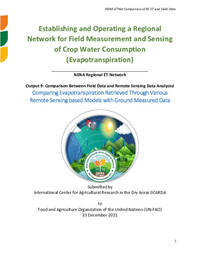Output 9: Comparison Between Field Data and Remote Sensing Data Analyzed Comparing Evapotranspiration Retrieved Through Various Remote Sensing based Models with Ground Measured Data

Authors:
Evapotranspiration (ET) measurement on a real-time basis at a large scale with high temporal
frequency is important for agricultural water use and water resource planning. Identifying the differences
between potential ET and crop ET at fine spatial resolutions is essential for management of agriculture
and water resources. It could contribute to the water deficit assessment at the individual farm level. This
study evaluates the potential of remote sensing-based models at five different locations in the Near East
and North African (NENA) region. Ground-based ET was determined for these locations during different
crop growing seasons. Remote sensing-based ET estimates generated through three remote sensingbased
models (WaPOR, METRIC, and SEBAL) were compared with ground-based estimates. This
comparative analysis evaluated the remote sensing-based modelling approaches and identified the model
that generated the closest estimates to the ground estimates. Results showed that SEBAL and METRIC
performed well except few locations. SEBAL showed highest index of agreement (d) (0.49 to 0.91)
between observed and estimated ET data followed by METRIC (0.40 to 0.66) and WaPOR (0.31 to 0.61)
for all seasons. Overall, the model's performance parameters showed that SEBAL had the smallest nRMSE
and uncertainty and the largest Ratio of Performance to Deviation (RPD) and (d) compared to the other
two models. RPD has been used as the standard way to report the quality of a model. Therefore, the
results of this study reveal that SEBAL performed well for study locations followed by METRIC and WaPOR.
Another finding for the study locations is that the ground ET determination technique based on soil
moisture depletion (SMD) was less correlated with RS-based ET than other techniques.
